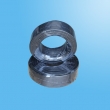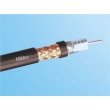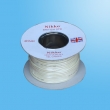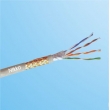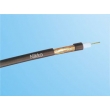Like any electrical power cord, coaxial cable conducts AC electric current between locations. Like these other cables, it has two conductors, the central wire and the tubular shield. At any moment the current is traveling outward from the source in one of the conductors, and returning in the other. However, since it is alternating current, the current reverses direction many times a second. Coaxial cable differs from other cable because it is designed to carry radio frequency current. This has a frequency much higher than the 50 or 60 Hz used in mains (electric power) cables, reversing direction millions to billions of times per second. Like other types of radio transmission line, this requires special construction to prevent power losses:
If an ordinary wire is used to carry high frequency currents, the wire acts as an antenna, and the high frequency currents radiate off the wire as radio waves, causing power losses. To prevent this, in coaxial cable one of the conductors is formed into a tube and encloses the other conductor. This confines the radio waves from the central conductor to the space inside the tube. To prevent the outer conductor, or shield, from radiating, it is connected to electrical ground, keeping it at a constant potential.
The dimensions and spacing of the conductors must be uniform. Any abrupt change in the spacing of the two conductors along the cable tends to reflect radio frequency power back toward the source, causing a condition called standing waves. This acts as a bottleneck, reducing the amount of power reaching the destination end of the cable. To hold the shield at a uniform distance from the central conductor, the space between the two is filled with a semirigid plastic dielectric. Manufacturers specify a minimum bend radius to prevent kinks that would cause reflections. The connectors used with coax are designed to hold the correct spacing through the body of the connector.
Each type of coaxial cable has a characteristic impedance depending on its dimensions and materials used, which is the ratio of the voltage to the current in the cable. In order to prevent reflections at the destination end of the cable from causing standing waves, any equipment the cable is attached to must present an impedance equal to the characteristic impedance (called 'matching'). Thus the equipment "appears" electrically similar to a continuation of the cable, preventing reflections. Common values of characteristic impedance for coaxial cable are 50 and 75 ohms.



